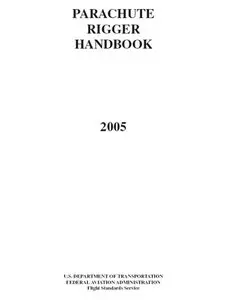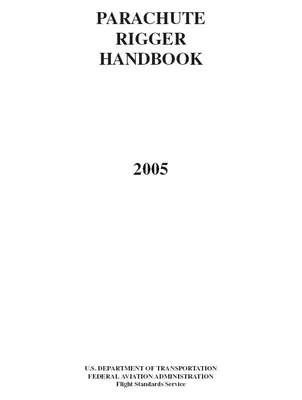Parachute Rigger Handbook
U.S. Department of Transportation, Federal Aviation Administration, Airmen Testing Standards Branch
FAA | 2005 | ISBN: n/a | 344 pages | PDF | 40 MB
U.S. Department of Transportation, Federal Aviation Administration, Airmen Testing Standards Branch
FAA | 2005 | ISBN: n/a | 344 pages | PDF | 40 MB
This operational handbook introduces the basic skills necessary for acquiring a parachute rigger certificate. This handbook is primarily intended to assist individuals who are preparing for the parachute rigger airman knowledge test and the oral and practical test.
The material presented in this handbook is appropriate for senior and master parachute riggers. The handbook contains information on regulations and human factors, design and construction, materials, operations, inspection and packing, hand tools, sewing machines, the parachute loft, repairs, alterations, and manufacture.
Contents
Chapter 1—Regulations and Human Factors
Parachute Rigger Certificates
Eligibility and Requirements
Earning a Parachute Rigger Certificate
Testing
Alternate Means of Qualifying for a Parachute Rigger Certificate
Retesting
Responsibilities of a Certificated Parachute Rigger
Facilities and Tools
Performance Standards
Currency Requirements
Record Keeping
Sealing the Parachute
Regulatory Compliance
14 CFR Part 1—Definitions
14 CFR Part 21 Subpart O—Technical Standard Orders (TSO)
14 CFR Part 39—Airworthiness Directives
14 CFR Part 91—General Operating and Flight Rules
14 CFR Part 105 Subpart C—Parachute Equipment and Packing
Rigging Ethics
Certification Specifications
Pilot vs Parachute Size
Parachute Service Life
Chapter 2—Design and Construction
Component Parts
Main Parachute
Reserve Parachute
Emergency Parachute
Harness/Container
Pilot Chutes and Bridles for the Main and Reserve Parachutes
Ripcords or Equivalent Devices for the Main and Reserve Parachutes
Deployment Devices for the Main and Reserve Parachutes
Main Parachute Release Mechanism and Associated Handles or Static Lines
Risers, Main or Reserve,When Not Integral With the Harness or Canopy, and Their Associated Steering Toggles
Other Harness/Container Assembly Components
TSO Standards
Canopy Design
Nomenclature
Construction Concepts and Techniques
Operational Theory
Materials
Damage
Containers
Configuration
Modern Design Concepts
Harness Design
Bridles and Deployment Devices
Deployment Types
Type 1: Canopy First Deployment
Type 2: Two-Stow Diaper or Half Diaper
Type 3: Ascuitto or Piglet-Style Flat Diaper
Type 4: Handbury or Preserve Full Diaper
Type 5: Free Bag
Type 6: Sleeves
Securing the Deployment Device
Bridles
Pilot Chutes
Spring-Loaded Pilot Chutes
Hand Deploy Pilot Chutes
Automatic Activation Devices and Reserve Static Lines
Automatic Activation Devices
Operation
Reserve Static Line Systems
RSL Designs
Main Riser Attachment
Ripcord Cable Routing
RSL Lanyard and Container Mount
Joint Efficiency
Chapter 3—Materials
Specifications
Fabrics
Webbing and Tapes
Cords, Lines, and Threads
Hardware
Plastics and Synthetics
Fasteners
Housings
Ripcords, Cables, and Swages
Miscellaneous
Chapter 4—Operations
Sport Parachute Main Packing Techniques
Deployment and Inflation Characteristics
Main Pilot Chute
Bridle Length
Rubber Bands
Assembly of the Main Canopy to the Harness and Container
Assembly of Components and Compatibility
Volume
Deployment Type
TSO Certification and Placard Limitations
Chapter 5—Inspection and Packing
Identification
Inspection
Component Compatibility
Round Canopies and Pilot Emergency Systems
Straightening the Canopy
Damage Identification
Pilot Chute and Bridle
Reserve Canopy
Suspension Lines and Connector Links
Harness
Container
Ripcord
Airing and Drying
Ram-Air Reserves and Sport Piggyback Systems
Pilot Chute and Free Bag/Bridle
Ram-Air Reserve Canopy
Canopy Assembly and Line Continuity
Inspection
Harness
Container
Ripcord
Rigging and Repairs
Packing
Round Canopy into a Pilot Emergency Parachute System
Layout
Pleating the Canopy
Fold the Skirt
Closing the Diaper and Stowing the Lines
Skirt or Diaper Placement
Accordion Folding the Canopy
Closing the Container
Ripcord Pull Force
Sealing the Parachute
Ram-Air Reserve into a Sport Piggyback System
Assembling the Reserve System
Step 1. Layout, and Setting Up Packing Clamps
Step 2. Stacking and Pleating the Reserve Canopy
Step 3. Setting the Brakes
Step 4. Folding the Canopy
Step 5. Placing the Canopy into the Deployment Bag and Stowing the Lines
Step 6. Placing the Bag into the Container and Closing the Container
Documentation
Chapter 6—Hands Tools, Sewing Machines, and the Parachute Loft
Hand Tools
Hand Tools Description
Sewing Machines
Identification and Nomenclature
Sewing Theory
Needles
Operation
Installing the Needle and Threading the Machine
Machine Maintenance
Sewing Machine Attachments
The Parachute Loft
Chapter 7—Repairs, Alterations, and Manufacture
Repair Techniques
Section 1—Canopy and Lines
7.1.1 Seam Restitching
7.1.2 Canopy Ripstop Tape Repair
7.1.3 Round and Square Canopy—Basic Patch
7.1.4 Round Canopy—Panel Replacement
7.1.5 Square Canopy—Partial Panel Replacement
7.1.6 Square Canopy—Rib Repair
7.1.7 Square Canopy—Pilot Chute Attachment Point Repair
7.1.8 Round Canopy—Noncontinuous Line Replacement
7.1.9 Square Canopy—Main Line Replacement
7.1.10 Square Canopy—Line Splice
7.1.11 Square Canopy—Control Line Replacement
7.1.12 Square Canopy—Crossport Repair
7.1.13 Square Canopy—Trim Check and Retrim
Section 2—Container
7.2.1 Container Fabric Panel Repair
7.2.2 Container Grommet Replacement
7.2.3 Container Velcro® Replacement
7.2.4 Container Plastic Stiffener Replacement
7.2.5 Main Container Side Flap Replacement
7.2.6 Bottom of Container Pocket Replacement
7.2.7 3-Ring Release Housing Replacement
Section 3—Harness and Risers
7.3.1 Chest Strap Replacement
7.3.2 Lower Leg Strap Shortening
7.3.3 Ripcord Pocket Velcro® Replacement
7.3.4 Articulated Upper Leg Hardware Replacement
7.3.5 Standard Harness Main Lift Web Replacement
7.3.6 Main Riser 3-Ring Locking Loop Replacement
7.3.7 Main Riser Steering Toggle Velcro® Replacement
Section 4—Accessory Components
7.4.1 Reserve Pilot Chute Repair—Mesh, Tackings, and Bad Grommet
7.4.2 Reserve Free Bag Repair—Grommet Pullout
7.4.3 Main Pilot Chute Repair—Top Canopy Reinforcing
7.4.4 Main Pilot Chute Collapsible Bridle Replacement
7.4.5 Main Deployment Bag Repair—Closing Flap Grommet Pullout
Section 5—Alterations
7.5.1 Articulated Harness Main Lift Web Resizing
7.5.2 Leg Pad Resizing
7.5.3 Automatic Activation Device Installation
Section 6—Manufacturing
7.6.1 Main and Reserve Closing Loop Manufacture
7.6.2 Main Deployment Bag
7.6.3 Bottom of Container Pocket
Section 7—Miscellaneous
7.7.1 Hand Tacking Techniques
7.7.2 Cleaning and Washing Procedures
Appendix I—Technical Documents
PIA TS-100—Standardized Nomenclature for Ram-Air Inflated Gliding Parachutes
PIA TS-108—Parachute Canopy Fabric Pull Test, Non-Destructive Method
TSO C23d—Personnel Parachute Assemblies
SAE AS 8015B—Minimum Performance Standards for Parachute Assemblies and Components, Personnel
TSO C23c—Personnel Parachute Assemblies
SAE AS 8015A—Minimum Performance Standards for Parachute Assemblies and Components, Personnel
TSO C23b—Parachutes
NAS 804—Specification–Parachutes
Glossary
Index
with TOC BookMarkLinks



